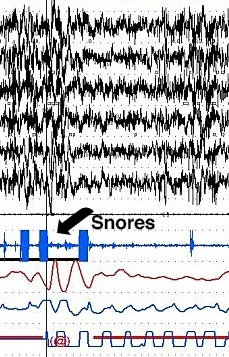Sleep apnea: Difference between revisions
Kashish Goel (talk | contribs) No edit summary |
m (Bot: Removing from Primary care) |
||
| (30 intermediate revisions by 12 users not shown) | |||
| Line 1: | Line 1: | ||
__NOTOC__ | |||
{{Sleep apnea}} | |||
{{Infobox_Disease | | {{Infobox_Disease | | ||
Name = | Name = Sleep Apnea | | ||
Image = Sleep apnea.jpg| | Image = Sleep apnea.jpg| | ||
Caption = | | Caption = | | ||
Width = 250px| | Width = 250px| | ||
}} | }} | ||
'''For patient information about sleep apnea click [[Sleep apnea (patient information)|here]]''' | |||
'''For patient information about central sleep apnea click [[Central sleep apnea (patient information)|here]]''' | |||
{{CMG}}; {{AE}} [[Saarah T. Alkhairy, M.D.]] | |||
==[[Sleep apnea overview|Overview]]== | |||
==Obstructive | [[Clinical practice guideline]]s by the [[United States Preventive Services Task Force]]<ref name="pmid28118461">US Preventive Services Task Force. Bibbins-Domingo K, Grossman DC, Curry SJ, Davidson KW, Epling JW et al. (2017) [https://www.ncbi.nlm.nih.gov/entrez/eutils/elink.fcgi?dbfrom=pubmed&retmode=ref&cmd=prlinks&id=28118461 Screening for Obstructive Sleep Apnea in Adults: US Preventive Services Task Force Recommendation Statement.] ''JAMA'' 317 (4):407-414. [http://dx.doi.org/10.1001/jama.2016.20325 DOI:10.1001/jama.2016.20325] PMID: [https://pubmed.gov/28118461 28118461]</ref> and the American Academy of Sleep Medicine<ref name="pmid28162150">{{cite journal| author=Kapur VK, Auckley DH, Chowdhuri S, Kuhlmann DC, Mehra R, Ramar K et al.| title=Clinical Practice Guideline for Diagnostic Testing for Adult Obstructive Sleep Apnea: An American Academy of Sleep Medicine Clinical Practice Guideline. | journal=J Clin Sleep Med | year= 2017 | volume= 13 | issue= 3 | pages= 479-504 | pmid=28162150 | doi=10.5664/jcsm.6506 | pmc=5337595 | url=https://www.ncbi.nlm.nih.gov/entrez/eutils/elink.fcgi?dbfrom=pubmed&tool=sumsearch.org/cite&retmode=ref&cmd=prlinks&id=28162150 }} </ref><ref name="pmid29183053">{{cite journal| author=Mokhlesi B, Cifu AS| title=Diagnostic Testing for Obstructive Sleep Apnea in Adults. | journal=JAMA | year= 2017 | volume= 318 | issue= 20 | pages= 2035-2036 | pmid=29183053 | doi=10.1001/jama.2017.16722 | pmc= | url=https://www.ncbi.nlm.nih.gov/entrez/eutils/elink.fcgi?dbfrom=pubmed&tool=sumsearch.org/cite&retmode=ref&cmd=prlinks&id=29183053 }} </ref> address screening and diagnosis. | ||
==[[Sleep apnea historical perspective|Historical Perspective]]== | |||
==[[Sleep apnea classification|Classification]]== | |||
==[[Sleep apnea pathophysiology|Pathophysiology]]== | ==[[Sleep apnea pathophysiology|Pathophysiology]]== | ||
==[[Sleep apnea causes|Causes]]== | ==[[Sleep apnea causes|Causes]]== | ||
== Diagnosis == | |||
==[[Sleep apnea differential diagnosis|Differentiating Sleep Apnea From Other Diseases]]== | |||
==[[Sleep apnea epidemiology and demographics|Epidemiology and Demographics]]== | |||
==[[Sleep apnea risk factors|Risk Factors]]== | |||
==[[Sleep apnea screening|Screening]]== | |||
==[[Sleep apnea natural history, complications and prognosis|Natural History, Complications and Prognosis]]== | |||
==Diagnosis== | |||
[[Sleep apnea diagnostic criteria|Diagnostic Criteria]] | [[Sleep apnea history and symptoms|History and Symptoms]] | [[Sleep apnea physical examination|Physical Examination]] | [[Sleep apnea laboratory findings|Laboratory Findings]] | [[Sleep apnea CT|CT]] | [[Sleep apnea MRI|MRI]] | [[Sleep apnea echocardiography or ultrasound|Echocardiography or Ultrasound]] | [[Sleep apnea other imaging findings|Other Imaging Findings]] | [[Sleep apnea other diagnostic studies|Other Diagnostic Studies]] | |||
==Treatment== | ==Treatment== | ||
[[Sleep apnea medical therapy|Medical Therapy]] | [[Sleep apnea surgery|Surgery]] | [[Sleep apnea primary prevention|Primary Prevention]] | [[Sleep apnea secondary prevention|Secondary Prevention]] | [[Sleep apnea cost-effectiveness of therapy|Cost-Effectiveness of Therapy]] | [[Sleep apnea future or investigational therapies|Future or Investigational Therapies]] | |||
== | ==Case Studies== | ||
{{Diseases of the nervous system}} | {{Diseases of the nervous system}} | ||
{{SleepSeries2}} | {{SleepSeries2}} | ||
[[es:Síndrome de apnea-hipopnea durante el sueño]] | [[es:Síndrome de apnea-hipopnea durante el sueño]] | ||
[[fr:Apnée du sommeil]] | [[fr:Apnée du sommeil]] | ||
[[ja:睡眠時無呼吸症候群]] | [[ja:睡眠時無呼吸症候群]] | ||
[[pt:Apnéia do sono]] | [[pt:Apnéia do sono]] | ||
[[zh:睡眠呼吸暂停]] | [[zh:睡眠呼吸暂停]] | ||
[[tr:Uyku Apnesi]] | [[tr:Uyku Apnesi]] | ||
{{WH}} | |||
{{WS}} | |||
[[Category:Pulmonology]] | [[Category:Pulmonology]] | ||
[[Category:Cardiology]] | [[Category:Cardiology]] | ||
Latest revision as of 00:12, 30 July 2020
|
Sleep Microchapters |
|
Diagnosis |
|---|
|
Treatment |
|
Case Studies |
|
Sleep apnea On the Web |
|
American Roentgen Ray Society Images of Sleep apnea |
| Sleep Apnea | |
 |
|---|
For patient information about sleep apnea click here
For patient information about central sleep apnea click here
Editor-In-Chief: C. Michael Gibson, M.S., M.D. [1]; Associate Editor(s)-in-Chief: Saarah T. Alkhairy, M.D.
Overview
Clinical practice guidelines by the United States Preventive Services Task Force[1] and the American Academy of Sleep Medicine[2][3] address screening and diagnosis.
Historical Perspective
Classification
Pathophysiology
Causes
Differentiating Sleep Apnea From Other Diseases
Epidemiology and Demographics
Risk Factors
Screening
Natural History, Complications and Prognosis
Diagnosis
Diagnostic Criteria | History and Symptoms | Physical Examination | Laboratory Findings | CT | MRI | Echocardiography or Ultrasound | Other Imaging Findings | Other Diagnostic Studies
Treatment
Medical Therapy | Surgery | Primary Prevention | Secondary Prevention | Cost-Effectiveness of Therapy | Future or Investigational Therapies
Case Studies
Template:Diseases of the nervous system Template:SleepSeries2 Template:WH Template:WS
- ↑ US Preventive Services Task Force. Bibbins-Domingo K, Grossman DC, Curry SJ, Davidson KW, Epling JW et al. (2017) Screening for Obstructive Sleep Apnea in Adults: US Preventive Services Task Force Recommendation Statement. JAMA 317 (4):407-414. DOI:10.1001/jama.2016.20325 PMID: 28118461
- ↑ Kapur VK, Auckley DH, Chowdhuri S, Kuhlmann DC, Mehra R, Ramar K; et al. (2017). "Clinical Practice Guideline for Diagnostic Testing for Adult Obstructive Sleep Apnea: An American Academy of Sleep Medicine Clinical Practice Guideline". J Clin Sleep Med. 13 (3): 479–504. doi:10.5664/jcsm.6506. PMC 5337595. PMID 28162150.
- ↑ Mokhlesi B, Cifu AS (2017). "Diagnostic Testing for Obstructive Sleep Apnea in Adults". JAMA. 318 (20): 2035–2036. doi:10.1001/jama.2017.16722. PMID 29183053.